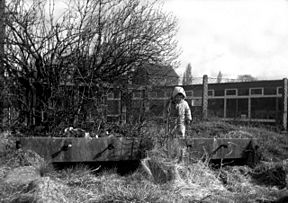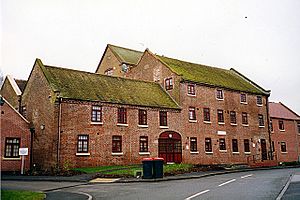Wombridge Canal facts for kids
Quick facts for kids Stourbridge Extension Canal |
|
|---|---|

Remains of a bridge over the infilled canal at Wrockwardine Wood in 1963
|
|
| Specifications | |
| Status | destroyed |
| History | |
| Principal engineer | William Reynolds |
| Date completed | 1788 |
| Date closed | 1921 |
| Geography | |
| Connects to | Shrewsbury Canal, Donnington Wood Canal |
The Wombridge Canal was a special type of waterway in Shropshire, England. It was built to move heavy materials like coal and iron ore. These materials came from mines and were taken to furnaces, which are like big ovens where iron is made.
The canal opened in 1788. Later, in 1792, parts of it were bought by the Shrewsbury Canal Company. This company built an amazing machine called an inclined plane at Trench. This plane helped move boats up and down a big hill. It could lower boats about 23 meters (75 feet)! This inclined plane was used until 1921, making it the very last one of its kind to operate in the whole country. The canal wasn't used much after 1919 and closed completely when the inclined plane stopped working.
Contents
Building the Wombridge Canal
Iron ore and coal were dug up near the church in a place called Wombridge. To get these materials to the iron furnaces at Donnington Wood, a man named William Reynolds decided to build a canal. He started building it in 1787, and it was finished in 1788.
The canal cost about £1,640, which was a lot of money back then. It was about 2.8 kilometers (1.75 miles) long. The canal connected the mines to the furnaces and also to another waterway called the Donnington Wood Canal.
Cool Canal Features
The Wombridge Canal had some interesting parts. One was a tunnel built near the church. It's a bit of a mystery why it was built, but some people think it was to keep a local landowner happy.
Another cool feature was an iron bridge. This bridge was made in sections and carried a road called Teague's Bridge Lane over the canal.
How the Canal Changed Hands
In 1792, a new company was formed, called the Shrewsbury Canal Company. They planned to build a canal all the way from Wombridge to Shrewsbury. This new company bought about 1.7 kilometers (1,848 yards) of the Wombridge Canal for £840.
Even though this was less than it cost to build, William Reynolds was a part-owner and a leader in the new company. The new law even said he wouldn't have to pay tolls for his own goods. It's also likely that by this time, he had already used up most of the minerals from the Wombridge mines.
The Trench Inclined Plane
The new Shrewsbury Canal Company built a special inclined plane to move tub boats. These boats needed to go from the higher level of the Wombridge Canal down to the lower level of the Shrewsbury Canal.
The inclined plane was about 74 meters (243 feet) long and dropped about 23 meters (75 feet). It had two railway tracks, and on each track, there was a special cradle. A single tub-boat would sit in this cradle to be moved up or down.
How the Inclined Plane Worked
A powerful engine, first built by the Coalbrookdale Company, provided the power for the inclined plane. This engine was replaced in 1842 by a new one that worked for 79 years! It kept going until the inclined plane finally closed on August 31, 1921.
Most of the boats were moving downwards, full of coal or iron. Empty boats would go up the other track to balance the weight. This inclined plane was the last one of its kind still working in the whole country.
The Wombridge Pumping Engine
Near the top of the inclined plane was a large building called the Wombridge Pumping Engine house. This engine was built in 1858 to pump water out of the mines. It was a huge machine!
The main part of the engine was about 152 centimeters (60 inches) wide, and its moving part went up and down about 3 meters (10 feet). It could lift water from a depth of around 183 meters (600 feet). The engine was very powerful, making about 250 horsepower. It usually ran slowly, lifting about 15 cubic meters (3,338 imperial gallons) of water every minute. When it ran at its fastest, it could do even more!
Industries Along the Canal
Before selling the canal, William Reynolds' sons, William and Joseph, built a glass factory. It was near Church Road Bridge. They made many things from dark green glass, like door-stops, rolling pins, jugs, and bottles for French wine. Their business did well for over 40 years before closing between 1835 and 1842.
Less than 274 meters (300 yards) to the west, John Bullock built a corn mill in 1818. This mill made flour. The Bullock family ran the mill until the 1940s. The building was made of red brick and used a steam engine for power. The original building had two floors, but a bigger four-story part was added in 1891. The mill closed in the 1970s and has since been turned into apartments.
Another business was owned by James Foster. He built two furnaces at Wombridge in 1818. He added a third furnace before 1843, when he closed the business and moved it to Madeley Court. In 1854, John Bennett reopened it for the Wombridge Iron Company. He also added a forge, which is a place where metal is shaped. This factory made wire and wire rods until 1900.
Why the Canal Closed
In 1919, new furnaces were built at Wombridge. This meant that most of the canal was not needed as much after that. The canal was officially closed in 1921 when the Trench inclined plane stopped working.
In 1968, parts of the inclined plane were used to fill in the canal basin, destroying what was left. The Wombridge engine house, which pumped water from the mines, lasted longer than the canal. But it was destroyed on December 27, 1964, using about 37 kilograms (82 pounds) of gelignite to blow it up.
Images for kids



